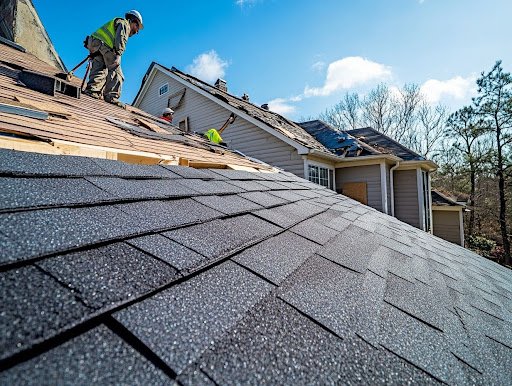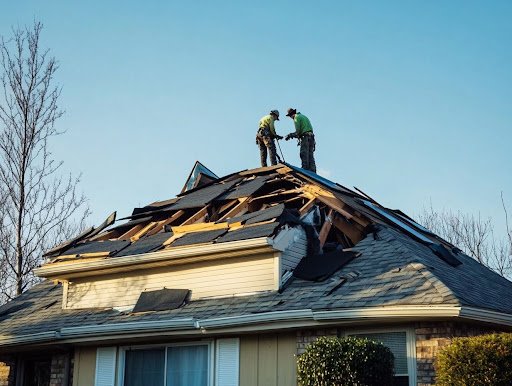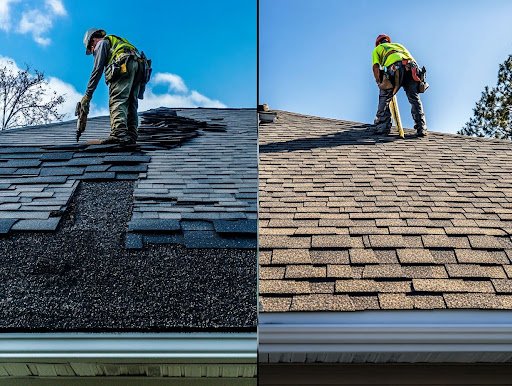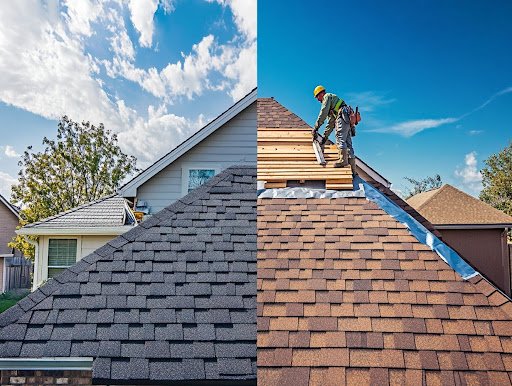Roof Repairs vs Roof Replacement: Which One?
- Trusted Roofing Professionals Sydney
- Free Quotes Available
- Contact Us Now
Deciding between roof repairs, roof replacement, and roof restoration presents a significant challenge for homeowners in Sydney, NSW. Understanding the key distinctions and recognising when to opt for one option over the other is essential for preserving the structural integrity of one’s home and enhancing its appearance. This guide outlines critical factors to consider, including the roof’s age, the extent of damage, budgetary constraints, and roofing options available. It further examines the processes involved in repair and replacement, complemented by a comprehensive cost comparison tailored to the specific needs of Sydney residents. Whether dealing with minor leaks or extensive damage, this guide assists homeowners in making an informed decision regarding their roofing requirements and roofing solutions.
Key Takeaways:
- Consider repairs if your roof is relatively new and the damage is minor, ensuring a cost-effective solution.
- Roof replacement is a better option for old or severely damaged roofs, improving energy efficiency and overall roofing aesthetics.
- When choosing between the two, consider factors such as budget, time constraints, the extent of damage, and professional roofing assessment.
What is the Difference between Roof Repairs and Roof Replacement?
Understanding the distinction between roof repairs and replacement is essential for homeowners in Sydney, NSW, as it can significantly affect property value, home investment, and long-term maintenance costs.
In contrast, roof replacement entails the removal of the existing roofing system and the installation of a new one. This process may become necessary when the roof has reached the end of its useful life or has sustained considerable damage due to adverse weather conditions or inadequate maintenance, impacting the roofing systems.

When to Consider Roof Repairs?
Homeowners should seriously consider roof repairs upon observing specific signs of damage, such as leaks, missing tiles, or minor wear that does not compromise the overall structural integrity of the roofing system.
Recognising these indicators is crucial, as they often result from common issues such as storm impacts, where high winds and heavy rainfall can lead to visible damage, or the natural ageing of roofing materials, which can deteriorate over time. Additional contributors may include seasonal temperature fluctuations that cause expansion and contraction, potentially resulting in cracks or weak spots. Promptly addressing these problems can help homeowners avoid incurring significant repair expenses.
- Regular inspections can aid in the early detection of such signs.
- Homeowners are encouraged to document any visible damage and consult with professionals for a comprehensive evaluation.
- This proactive strategy not only safeguards their investment but also enhances the kerb appeal of their property.
Timely maintenance is essential for ensuring roofing systems remain functional and resilient against future environmental elements and for addressing structural issues.
When to Consider Roof Replacement?
Roof replacement should be considered when the existing roof has reached its expected lifespan or exhibits significant structural issues that compromise its functionality and aesthetic appeal.
Several factors may necessitate a roof replacement, including severe storm damage that renders the surface vulnerable to further deterioration, extensive leaks that damage the roofing material and jeopardise the underlying structure, and outdated materials that fail to provide adequate protection and may require a new roofing system.
Recognising that a comprehensive assessment conducted by roofing professionals is crucial, considering homeowner responsibilities. These experts know how to identify hidden damages and recommend the most appropriate solutions.
- Ignoring these issues may result in increased repair costs in the future.
- Professional consultations ensure you remain informed about the best materials and options available, including roofing contract details.
Ultimately, making a well-informed decision will safeguard your home and investment for years, benefiting potential buyers.
Factors to Consider when Choosing between Roof Repairs and Roof Replacement
When evaluating the options between roof repairs and roof replacement, homeowners in Sydney, NSW, must consider several critical factors to make a well-informed decision that aligns with their roofing requirements, property objectives, and financial constraints.
Key considerations include the roof’s age, the extent of existing damage, the available budget for the project, and any time limitations that may influence the decision-making process.
A thorough understanding of these elements will enable homeowners to assess the most cost-effective solution while maintaining the integrity and longevity of their roofing system.
Age of Your Roof
The age of a roof is a critical factor in determining whether repairs or replacement are necessary, as different roofing materials, such as metal roofing and Colorbond, exhibit varying lifespans based on their type and installation quality.
Homeowners need to understand the expected longevity of their roofing material, as this knowledge significantly informs maintenance decisions. For instance, metal roofing typically lasts 40 to 70 years, whereas Colorbond roofs generally last 20 to 30 years.
Regular inspections are vital, as they can help identify potential issues early. Common indicators that may suggest a roof replacement include missing tiles, water leaks, or extensive rust on metal roofs.
Failing to address these concerns promptly can result in more extensive damage over time, impacting residential properties. Therefore, consulting with professional roofing experts who can assess the roof’s condition and provide tailored recommendations based on its specific age and material type is crucial.
Extent of Damage
The extent of damage to a roof is critical in determining whether repairs will effectively resolve the issues at hand or if a complete replacement is warranted, particularly in cases involving significant structural concerns.
Assessing roof damage necessitates a comprehensive approach and a roof inspection. It is advisable to begin with a visual inspection conducted safely from within the home, looking for indicators such as water stains on ceilings or walls that may suggest the presence of leaks.
- Check for missing or damaged tiles and granule loss, as these conditions can expose the underlying layers to adverse weather conditions.
- Examine the flashing around chimneys and roof lights, as these areas are particularly susceptible to deterioration.
An initial amateur assessment may not provide a complete understanding of the situation; this is where the expertise of roofing professionals becomes essential. Their specialised knowledge allows them to conduct thorough inspections, utilising specialised tools to identify underlying damage that may not be visible to the untrained eye.
Neglecting severe damage can escalate repair costs and potentially compromise the structural integrity of the entire building, leading to a costly repair bill. Therefore, it is imperative to address any identified issues promptly.
Budget
Budget constraints are critical in the decision-making process when evaluating roof repairs versus replacement, as both options can involve significantly different costs.
Understanding the financial implications is essential for any property owner. The cost of repairing a roof can range from a few hundred to several thousand pounds, primarily depending on the extent of the damage and the materials used, with financial considerations being crucial. Conversely, a complete roof replacement may require a much larger investment, often costing between £5,000 and £30,000, depending on the size and type of roofing, such as roofing materials.
Therefore, it is advisable to:
- Conduct a thorough assessment of the roof’s current condition.
- Obtain multiple quotes from local contractors.
- Explore financing options and roofing plans that may alleviate the immediate financial burden.
By carefully considering these factors, property owners can make informed decisions that address urgent needs and enhance the property’s investment value.

Time Constraints
Time constraints can significantly influence homeowners’ decisions regarding roof repairs versus a full replacement. Roof repairs are often completed more swiftly, effectively addressing immediate roofing issues.
When confronted with unexpected leaks or damage, the situation’s urgency frequently drives homeowners to pursue emergency roof repairs or restoration. Prompt action is essential to prevent further structural issues and protect interior spaces. These quick fixes effectively address visible problems such as missing tiles or minor leaks, allowing residents to maintain their daily routines with minimal disruption and meet local council safety requirements.
In contrast, a planned roof replacement necessitates careful consideration and deliberate scheduling with roofing contractors, as this process can extend over several weeks or even months. Homeowners must also consider various factors, including materials, permissions, weather conditions, and existing roof conditions, which can impact the timeline.
- Emergency repairs: swift solutions for urgent concerns.
- Planned replacements: a more extensive process requiring attention to detail and roof maintenance.
- Consultation with contractors for customised solutions.
Roof Repair Process
The roof repair process consists of critical steps designed to provide effective and enduring solutions for homeowners experiencing roofing issues, enhance the home’s aesthetic appeal, achieve property goals, and preserve its structural integrity.
Initially, skilled roofing professionals thoroughly inspect the roof to evaluate its current condition and identify specific repair needs. Following this assessment, the team prepares the work area by clearing any debris and safeguarding adjacent structures before performing the necessary repair, which may involve patching leaks or replacing damaged roofing materials.
Ultimately, a comprehensive final inspection is carried out to ensure that all repairs comply with safety regulations and meet established quality standards.
Inspection
The initial step in the roof repair process involves a comprehensive inspection carried out by roofing professionals to assess the roof’s current condition and identify areas of damage that require attention.
This critical evaluation is essential for developing a strategic approach to repairs. During the inspection, experts typically examine various indicators of deterioration, such as missing tiles, leaks, or water damage that may not be readily visible from the ground.
They assess the integrity of flashing, gutters, and the overall structural framework of the roof. By meticulously attending to these details, professionals can provide clients with a thorough understanding of the roof’s condition and recommend the most effective repair solutions.
Ultimately, these inspections serve not only to extend the lifespan of the roof but also to safeguard the property’s interior from potential hazards arising from undetected issues.
Preparation
Preparation for roof repairs necessitates the establishment of a safe and efficient workspace, enabling roofing professionals to address the identified issues while minimising disruptions effectively.
The first step in this process involves thoroughly assessing the area to identify potential hazards, such as electrical wires or unstable structures. Once these hazards are identified, workers must wear appropriate safety gear—including hard hats, gloves, and non-slip footwear—to ensure their well-being.
Subsequently, clearing the work area of debris, tools, and any other obstacles that could pose a risk during the repair process is essential. This includes relocating furniture or belongings that may be at risk from falling materials. Maintaining a tidy workspace promotes safety and cost savings and enhances efficiency, allowing roofing professionals to concentrate on the task at hand.
Moreover, setting up barriers or warning tape around the perimeter is crucial to prevent unauthorised access and to inform others of ongoing work. By undertaking these comprehensive preparatory steps, roofing professionals can confidently commence repairs, ensuring that they operate in a secure and organised environment.
Repair Work
The actual repair work is where roofing professionals apply solutions to address the identified issues, which may include applying waterproof coatings, replacing damaged roof tiles, or reinforcing weak areas within the roof.
These interventions are essential for maintaining the integrity of the entire structure. For instance, waterproof coatings are critical in preventing moisture infiltration, which can lead to significant deterioration over time. Similarly, replacing damaged roof tiles ensures that the protective layer of the roof remains intact, thereby preventing leaks and associated problems, while reinforcing weak areas enhances overall stability.
During these repairs, specialised materials such as synthetic underlay and durable flashing are frequently utilised. Incorporating these materials substantially contributes to the roof’s longevity by providing additional protection against external elements, thus extending the overall life expectancy of the roofing system.
Final Inspection
The final inspection is a critical step in roof repair. It ensures that all repairs have been conducted accurately and comply with safety requirements.
This phase is essential for verifying the structural integrity and confirming that the materials and techniques used align with industry standards and regulations. Roofing professionals meticulously evaluate various aspects during this assessment to ensure the longevity and reliability of the roof.
They examine the proper installation of roof tiles or slats to prevent leaks. Attention is also given to the flashing and seals around vents and chimneys. Furthermore, they assess the overall craftsmanship to guarantee that each layer is installed precisely.
By performing a comprehensive final inspection, roofing experts can assure homeowners that the repairs will withstand the elements, enhancing the structure’s durability and performance.

Roof Replacement Process
The roof replacement process is a detailed procedure that entails several essential steps to facilitate a successful transition to a new roofing system, thereby enhancing the home’s structural integrity and energy efficiency.
Initially, a comprehensive roof inspection is conducted to evaluate the existing roof’s condition and determine the extent of replacement required.
Following this assessment, homeowners collaborate with roofing contractors to select the most appropriate roofing materials, considering factors such as durability, aesthetic appeal, and budgetary constraints.
The subsequent step involves removing the old roof, which may necessitate specialised equipment and adherence to safety protocols to ensure a secure and efficient operation.
Once the old roofing materials are removed, the installation of the new roof commences, culminating in a final inspection to confirm that the replacement complies with all safety and quality standards.
Inspection
The roof inspection is the initial and critical step in the roof replacement process. It allows roofing contractors to evaluate the condition of the existing roof and define the scope of the replacement work.
During a comprehensive roof inspection, contractors assess various factors, including any visible damage, such as missing tiles, cracks, or signs of water leakage. This essential examination aids in determining the roof’s remaining lifespan and identifying any underlying issues that may complicate replacement efforts.
A detailed inspection significantly influences the replacement plan, ensuring that all necessary repairs are addressed and appropriate materials are selected. By thoroughly evaluating the structure, inspectors also ensure compliance with safety standards, ultimately enhancing the new roof’s overall durability.
Key elements of this assessment include:
- Assessment of structural integrity and roofing technologies
- Identification of potential leaks
- Evaluation of insulation effectiveness
- Determination of repair needs
This comprehensive assessment guarantees a thorough understanding of the roof’s requirements, facilitating the development of an effective and lasting solution.
Material Selection
Selecting appropriate roofing materials is of paramount importance during the roof replacement process. Homeowners must balance aesthetic appeal, energy efficiency, and durability to ensure a long-lasting investment, considering sustainable options.
Many homeowners evaluate various options, assessing the advantages of metal roofing in comparison to traditional materials. Metal roofing is highly regarded for its durability and longevity, often exceeding 50 years with minimal maintenance. It offers superior protection against adverse weather conditions and features reflective properties that can contribute to reduced energy consumption by maintaining cooler indoor temperatures during hot summer months.
Conversely, Colorbond roofs, which are widely favoured in many regions, provide a vibrant array of roof colour ranges while demonstrating high energy efficiency. These roofs can enhance the visual appeal of a home’s exterior and complement its architectural design.
Key considerations include:
- Durability: Metal roofing typically outlasts many traditional materials.
- Energy Efficiency: Reflective surfaces like Dulux Acratex can lead to lower utility costs.
- Aesthetics: An extensive selection of styles and colours, including new paint colour options, is available to suit individual preferences.
Homeowners should carefully evaluate how each roofing material aligns with their energy goals and overall aesthetic preferences to make a well-informed decision.
Removal of Old Roof: Initial Roof Assessment
The removal of the old roof is a critical phase in the roof replacement process, necessitating careful planning and execution by roofing contractors to ensure both safety and efficiency.
This endeavour typically begins with a comprehensive risk assessment to identify potential hazards and ensure a secure work environment for all personnel involved. Roofing contractors must wear appropriate personal protective equipment (PPE), including hard hats, gloves, and non-slip footwear, to safeguard against falls and debris.
To facilitate an orderly process, contractors will gather essential equipment, such as:
- Roofing shovels and pry bars for the removal of old shingles
- Skip bins for efficient debris disposal
- Ladders and scaffolding to safely access elevated areas
Ahead of commencing work, the site is meticulously prepared, which includes:
- Sealing off the work area to ensure pedestrian safety
- Protecting landscaping and adjacent structures
- Ensuring all tools and materials are readily available
These steps guarantee that the project proceeds smoothly and that the subsequent roofing installation can be completed without complications.
Installation of New Roof
The installation of the new roof proceeds after the removal of the existing roof and entails the application of new roofing materials, such as high-build roof membrane, according to the specifications approved during the material selection phase.
Once the old materials have been removed, the installation process can commence. Skilled contractors typically begin by meticulously assessing the existing structure to ensure it meets the requisite standards for support and durability. Adherence to manufacturer guidelines is critical at this juncture, as each type of roofing material—be it shingles, metal, or tiles—has specific recommendations that must be followed to ensure optimal performance and longevity. Applying appropriate techniques, such as ensuring correct insulation and ventilation, is also essential.
- A comprehensive inspection of the roof decking is conducted to identify any damage that may require repair.
- Following the verification of the foundation, an underlayment is applied to provide an additional layer of protection against moisture.
- The roofing materials are installed precisely, ensuring secure fastening to withstand adverse weather conditions.
By entrusting the installation to experienced roofing contractors, clients can be confident that each step adheres to industry best practices, resulting in a finished product that guarantees durability and effectiveness.
Final Inspection: Evaluating Roofing Costs
A final inspection concludes the roof replacement process, enabling roofing contractors to verify that the new roofing system has been installed correctly and complies with all safety regulations.
This crucial step is not merely a formality; it guarantees homeowners that their investment in a new roof will endure over time. Roofing professionals conduct a thorough examination of various aspects of the installation, including:
- Overall Structural Integrity: They assess the roof’s framework to ensure compliance with design standards.
- Flashing and Sealing: Properly installing these components is essential to prevent leaks and water damage.
- Ventilation and Insulation: Adequate ventilation helps maintain temperature control, while sufficient insulation can enhance energy efficiency.
Through this comprehensive evaluation, contractors ensure the optimal performance of the roofing system and extend its lifespan, thereby providing safety and security for years to come.

Cost Comparison between Roof Repairs and Roof Replacement
When evaluating roofing options, homeowners must perform a comprehensive cost comparison between roof repairs and roof replacement. This analysis can substantially impact their budget and long-term financial planning for the maintenance of their residential properties.
By understanding the costs associated with each option, homeowners are better positioned to make informed decisions that align with their financial considerations while ensuring the longevity and functionality of their roofing systems.
Various factors contribute to these costs, including the nature of the repairs required, the materials selected for replacement, and the labour involved in both processes.
Cost of Materials
The cost of materials is a significant factor in determining the overall expenses associated with roof repairs and replacement, as different roofing materials come with varying price points and durability.
When selecting roofing materials, it is essential to consider the initial investment and the long-term implications regarding maintenance and longevity. For example, economical options such as asphalt shingles may appear attractive due to their low upfront cost; however, they often necessitate more frequent repairs and have a shorter lifespan compared to higher-quality alternatives like metal or tile roofing. Although these premium materials may require a greater initial financial commitment, they typically offer enhanced durability and minimal maintenance, reducing repair costs.
- Asphalt Shingles: Economical, short lifespan, frequent repairs.
- Metal Roofing: Higher initial cost, more extended durability, minimal upkeep.
- Tile Roofing: Premium option, excellent longevity, aesthetic value.
Understanding the balance between cost and durability can facilitate more informed financial decisions for property owners seeking sustainability in their roofing choices.
Labor Costs
Labour costs associated with roof repairs and replacements can significantly impact the overall budget, as skilled roofing professionals often command higher rates due to their expertise and experience. Investing in experienced contractors can lead to long-term savings, as they typically provide more durable solutions, reducing the likelihood of future repairs.
The variation in labour costs is frequently attributed to the complexity of repairs compared to the comprehensive nature of replacements. Although repairs may initially appear less expensive, this perception can be misleading if executed incorrectly. Without the appropriate expertise, a hastily performed fix may result in recurring issues, necessitating additional expenditures in the future.
Therefore, when evaluating potential hires, it is essential to consider the following:
- The contractor’s qualifications and previous work history, including collaborations with Watermaster Roofing.
- They provide warranties on labour and materials.
- Customer reviews and feedback regarding their workmanship.
Ultimately, collaborating with qualified roofing professionals ensures that the job is completed correctly the first time and affords peace of mind that the investment will endure over time.
Additional Costs
Homeowners should consider any additional costs that may arise during roof repairs or replacement. This includes potential upgrades, unforeseen structural issues, and necessary permits mandated by the local council.
When planning a roofing project, it is essential to recognise that unexpected expenses can significantly affect the overall budget. For example, upgrades to enhance insulation or energy efficiency may provide long-term benefits but could also contribute to the total expenditure. Structural issues, such as damaged rafters or leaking gutters, may emerge and often require immediate attention and additional financial resources.
- Permits: Depending on local regulations, obtaining the appropriate licenses may incur extra fees.
- Material costs: The prices of roofing materials can fluctuate, impacting the final invoice.
- Labour expenses: Engaging qualified professionals ensures quality workmanship; however, labour rates vary considerably.
Effective budgeting requires considering these common additional costs to avoid unexpected financial burdens during the project.
Which One is More Suitable for Sydney, NSW Residents? Making the Right Roofing Decision.
For homeowners in Sydney, NSW, determining whether roof repairs or replacement are more appropriate depends on several local factors. These include climate conditions, building regulations enforced by the local council, and the quality of workmanship offered by roofing professionals in the region.
A thorough understanding of Sydney’s unique environmental characteristics, such as its susceptibility to heavy rainfall and significant sun exposure, can offer valuable insights into the longevity and performance of various roofing options. This contextual knowledge enables homeowners to make informed decisions that align with their property objectives and financial considerations.
Climate Considerations
Climate considerations are crucial in determining the most appropriate roofing options for homeowners in Sydney, NSW, as local weather conditions significantly impact roof durability and maintenance.
It is essential to understand the specific climate factors in a region characterised by warm summers, occasional heavy rainfall, and mild winters, especially when considering a roofing makeover by companies like CBT Roofing. For example, high rainfall can lead to moisture accumulation, which increases the risk of leaks and mould if repairs are not adequately addressed. Likewise, temperature fluctuations can cause expansion and contraction in roofing materials, potentially affecting their structural integrity over time. Additionally, the intense UV exposure experienced in Sydney can accelerate the deterioration of certain roofing materials, leading to more rapid degradation.
Homeowners frequently find themselves deliberating between roof repairs and complete replacements, influenced by these climatic conditions. While traditional materials such as terracotta tiles provide good durability against heat and moisture, alternatives like Colorbond metal roofing and Dulux Acratex coatings are highly valued for their resilience to UV radiation and low maintenance requirements.
Ultimately, making an informed decision necessitates consideration of both immediate weather-related challenges and the long-term performance of the selected roofing materials.
Building Regulations
Understanding local building regulations is crucial for homeowners in Sydney, NSW, as these codes can significantly impact the feasibility and scope of roof repair and replacement projects.
The importance of adhering to these regulations cannot be overstated, as they are designed to ensure homeowner safety and structural integrity. It is essential to recognise that local council regulations outline a series of stipulations, which include:
- Permit requirements: These permits are mandatory for carrying out any substantial roofing modifications, safeguarding against unlicensed work.
- Compliance with safety standards: These codes encompass a range of safety measures intended to protect workers and residents during and after the project.
- Environmental considerations: Certain provisions may include restrictions on the materials used and the promotion of sustainable building practices.
When undertaking a roofing project, remaining informed about these specifications empowers homeowners to proceed without unnecessary obstacles and ensures that their investments are both legally compliant and structurally sound.
Quality of Workmanship
The quality of workmanship provided by roofing professionals is a crucial determinant of the success of both roof repairs and replacements. It significantly affects the durability of the roofing system and homeowners’ overall satisfaction.
When undertaking any roofing project, selecting experienced experts like Watermaster Roofing can significantly influence the outcome. Seasoned roofing professionals are more likely to use high-quality materials and possess the skills to address unforeseen complications effectively.
Homeowners are encouraged to review feedback from previous clients, as this can offer valuable insights into the contractor’s reliability and craftsmanship.
- Look for companies with strong local reputations.
- Seek out specific reviews that highlight timely project completion.
- Consider recommendations from friends or family.
By incorporating these strategies, homeowners can make informed decisions that will enhance their confidence and ensure a smoother roofing process.
Frequently Asked Questions
What is the difference between roof repairs and roof replacement?
Roof repairs involve fixing specific issues on a damaged roof, such as leaks or broken shingles. Roof replacement, on the other hand, involves completely removing and replacing the entire roof structure.
Which one is more cost-effective: roof repairs or roof replacement?
In most cases, roof repairs are more cost-effective than roof replacement. However, this depends on the extent of the damage and the roof’s age. It is best to consult a professional roofer to determine the most cost-effective solution for your situation.
When should I opt for roof repairs?
If the damage to your roof is localised and can be fixed without compromising the structure’s overall integrity, then roof repairs are the better option. This is usually the case for minor leaks, missing shingles, or small areas of damage.
When is roof replacement necessary?
Roof replacement is necessary when the damage to your roof is extensive and cannot be fixed with simple repairs. This may be the case when your roof is old, severely damaged from a storm, or has multiple issues that cannot be addressed individually.
How do I know if my roof needs repairs or replacement?
It is best to have a professional roofer assess the condition of your roof. They will be able to determine whether your roof can be repaired or replaced. Factors such as age, type of damage, and overall roof condition will be considered.
Can I DIY roof repairs or replacement?
A professional roofer should always do roof repairs and replacements. Attempting to DIY can lead to further damage and safety hazards. It is best to leave these tasks to experts with the necessary skills, knowledge, and equipment to complete the job safely and effectively.
